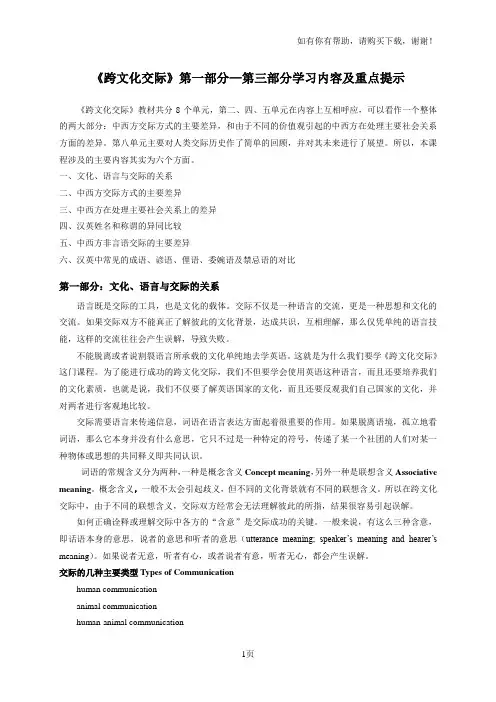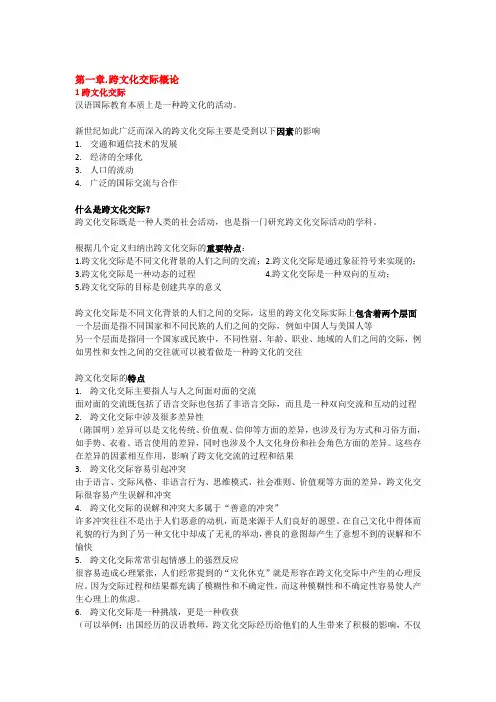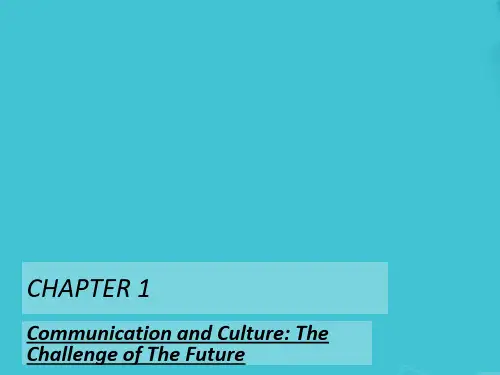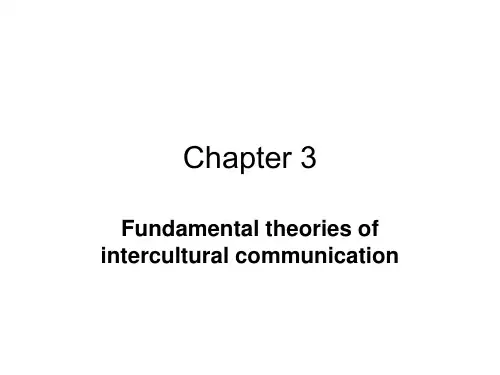Chapter_3_Cultural_values跨文化交际文化价值观模式
- 格式:ppt
- 大小:2.15 MB
- 文档页数:83



《跨文化交际》第一部分—第三部分学习内容及重点提示《跨文化交际》教材共分8个单元,第二、四、五单元在内容上互相呼应,可以看作一个整体的两大部分:中西方交际方式的主要差异,和由于不同的价值观引起的中西方在处理主要社会关系方面的差异。
第八单元主要对人类交际历史作了简单的回顾,并对其未来进行了展望。
所以,本课程涉及的主要内容其实为六个方面。
一、文化、语言与交际的关系二、中西方交际方式的主要差异三、中西方在处理主要社会关系上的差异四、汉英姓名和称谓的异同比较五、中西方非言语交际的主要差异六、汉英中常见的成语、谚语、俚语、委婉语及禁忌语的对比第一部分:文化、语言与交际的关系语言既是交际的工具,也是文化的载体。
交际不仅是一种语言的交流,更是一种思想和文化的交流。
如果交际双方不能真正了解彼此的文化背景,达成共识,互相理解,那么仅凭单纯的语言技能,这样的交流往往会产生误解,导致失败。
不能脱离或者说割裂语言所承载的文化单纯地去学英语。
这就是为什么我们要学《跨文化交际》这门课程。
为了能进行成功的跨文化交际,我们不但要学会使用英语这种语言,而且还要培养我们的文化素质,也就是说,我们不仅要了解英语国家的文化,而且还要反观我们自己国家的文化,并对两者进行客观地比较。
交际需要语言来传递信息,词语在语言表达方面起着很重要的作用。
如果脱离语境,孤立地看词语,那么它本身并没有什么意思,它只不过是一种特定的符号,传递了某一个社团的人们对某一种物体或思想的共同释义即共同认识。
词语的常规含义分为两种,一种是概念含义Concept meaning,另外一种是联想含义Associative meaning。
概念含义,一般不太会引起歧义,但不同的文化背景就有不同的联想含义。
所以在跨文化交际中,由于不同的联想含义,交际双方经常会无法理解彼此的所指,结果很容易引起误解。
如何正确诠释或理解交际中各方的“含意”是交际成功的关键。
一般来说,有这么三种含意,即话语本身的意思,说者的意思和听者的意思(utterance meaning; speaker’s meaning and hearer’s meaning)。

第一章.跨文化交际概论1跨文化交际汉语国际教育本质上是一种跨文化的活动。
新世纪如此广泛而深入的跨文化交际主要是受到以下因素的影响1.交通和通信技术的发展2.经济的全球化3.人口的流动4.广泛的国际交流与合作什么是跨文化交际?跨文化交际既是一种人类的社会活动,也是指一门研究跨文化交际活动的学科。
根据几个定义归纳出跨文化交际的重要特点:1.跨文化交际是不同文化背景的人们之间的交流;2.跨文化交际是通过象征符号来实现的;3.跨文化交际是一种动态的过程4.跨文化交际是一种双向的互动;5.跨文化交际的目标是创建共享的意义跨文化交际是不同文化背景的人们之间的交际,这里的跨文化交际实际上包含着两个层面一个层面是指不同国家和不同民族的人们之间的交际,例如中国人与美国人等另一个层面是指同一个国家或民族中,不同性别、年龄、职业、地域的人们之间的交际,例如男性和女性之间的交往就可以被看做是一种跨文化的交往跨文化交际的特点1.跨文化交际主要指人与人之间面对面的交流面对面的交流既包括了语言交际也包括了非语言交际,而且是一种双向交流和互动的过程2.跨文化交际中涉及很多差异性(陈国明)差异可以是文化传统、价值观、信仰等方面的差异,也涉及行为方式和习俗方面,如手势、衣着、语言使用的差异,同时也涉及个人文化身份和社会角色方面的差异。
这些存在差异的因素相互作用,影响了跨文化交流的过程和结果3.跨文化交际容易引起冲突由于语言、交际风格、非语言行为、思维模式、社会准则、价值观等方面的差异,跨文化交际很容易产生误解和冲突4.跨文化交际的误解和冲突大多属于“善意的冲突”许多冲突往往不是出于人们恶意的动机,而是来源于人们良好的愿望。
在自己文化中得体而礼貌的行为到了另一种文化中却成了无礼的举动,善良的意图却产生了意想不到的误解和不愉快5.跨文化交际常常引起情感上的强烈反应很容易造成心理紧张,人们经常提到的“文化休克”就是形容在跨文化交际中产生的心理反应。







《跨文化交流导论》(英) 教学大纲一、教学目标了解与跨文化交际相关的理论,对文化、交际、语言、跨文化交际等相关概念有较为系统的理解;提高跨文化意识和跨文化情感态度,能够较为客观、系统、全面地认识本国文化与目的语文化之间的差异,进而主动观察、分析、对比、评价这些差异现象;培养跨文化学习策略、跨文化语用能力和跨文化语言知识,能够恰当地处理因文化差异引起的跨文化误解和文化冲突;全面提高跨文化交际能力,在学习、工作和社会交往的跨文化环境下能用英语有效地进行交际,以适应我国社会发展和国际交流的需要。
二、课程描述跨文化交际是一门实践性很强的综合性应用学科,涉及人类学、语言学、心理学、社会学、文化学、民俗学等多学科,《跨文化交际导论(英)》通过讲座、讨论、案例研究等多种教学形式,运用图、文、声、情景并茂的教学手段,介绍跨文化交际学的理论体系和实践原则, 旨在通过分析中西文化在言语交际、非言语交际中的差异,以及这些差异在社会礼仪和商务谈判中的反映等,从而培养学生的跨文化意识,加强对母语和目的语文化的深刻理解力,最终提高跨文化交际能力,为学生今后的工作实践打下必备的基础。
本课程以英语为授课语言。
三、选用教材Fundamentals of Intercultural Communication 《跨文化交际基础》窦卫霖编著,对外经济贸易大学出版社,2007.4内容简介:教材共分九章,其中前六章以跨文化交际学的基本理论和主要内容为框架,第一章为概论,介绍跨文化交际的定义、概念、发展及其意义;第二章着重讨论交际的基本理论及其在人类交际中的应用;第三章阐述文化的性质,包括定义、作用、特征及其差异;第四章集中讨论价值观这一深层文化差异及其在商务活动中的表现;第五和第六章分别探讨了文化差异在言语和非言语交际方面的种种表现。
考虑到学生的实际需要,第七和第八章分别选择了社会礼仪和商务谈判这两个重要方面阐述文化差异的具体体现和跨文化交际理论的实践应用。
文化、跨文化交际、文化价值观的定义Definitions of CultureCulture is learned and shared within social groups and istransmitted from one generation to another for purposes of promoting individual and social survival, adaption, and growth and development. Generally speaking, culture means both human and society that have developed to a certain level in history. It consists of all forms of human lives and activities, and all the man-made material and spiritual wealth. Specifically speaking, it solely means “areas of man’ssp iritual life”. Cultureis created by man; it also continually creates human beings, countries, nations, personal characters, psychologies, behaviors, ways of thinking and various values.According to Samovar and Porter (2010), culture refers to the cumulative deposit of knowledge, experience, beliefs, values, attitudes, meanings, hierarchies, religion, notions of time, roles, spatial relations, concepts of the universe, and material objects and possessions acquired by a group of people in the course of generations through individual and group striving.Definitions of Intercultural CommunicationIntercultural communication occurs when a member of one culture produces a message for consumption by a number of another culture. More precisely, intercultural communication involves interaction betweenpeople whose cultural perception and symbol systems are distinct enough to alter the communication event.Intercultural communication in its most basic form refers to an academic field of study and research. It seeks to understand how people from different countries and cultures behave, communicate and perceive the world around them. The definition of intercultural communication must also include strands of the field that contribute to it such as anthropology, cultural studies, psychology and communication.According to the definition from Wikipedia, the free encyclopedia, intercultural communication is a form of global communication. It is used to describe the wide range of communication problems that naturally appear within an organization made up of individuals from different religious, social, ethnic, and educational backgrounds.Karlfried Knapp (1987) defines it as the interpersonal interaction between members of different groups, which differ from each other in respect of the knowledge shared by their members and in respect of their linguistic forms of symbolic behavior.”Definitions of Cultural ValueCultural values are values that tend to permeate a culture. They are the goodness or desirability of certain actions or attitudes among members of the culture. They are transmitted by a variety of sources (family, media, school, church, state, and so on) and therefore tend to be broad-based, enduring, and relatively stable. They guide bothperception and communication. That is, values get translated into action. An understanding of cultural values helps us appreciate the behavior of other people, knowing, for instance, that the American value of directness and the exchange of eye-contact, might cause us to apply one trick of focusing in the space between the eyebrows, and “faking it” until we can make eye contact ourselves. What is more, an awareness of cultural values also helps us understand our own behavior. For example, we can associate patience with the value of time, moderation with the value of harmony and consensus, and obligation with the twin value of friendship and sociability.Hu Wenzhong (1999), a famous cultural scholar in China, has pointed out that of all the problems discussed or studied in intercultural communication research, value is one of the most important problems and deserves great attention. Values come from social life and provide criteria for behavior. “They prescribe which actions and ways of being are better than others;they are not descriptions of fact,but possess contentand emotion and contribute to social reality.” Scholars haveoffered many versions ofdefinitions for values.。